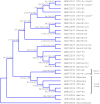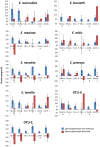Occurrence of Eimeria species parasites on small-scale commercial chicken farms in Africa and indication of economic profitability
- PMID: 24391923
- PMCID: PMC3877271
- DOI: 10.1371/journal.pone.0084254
Occurrence of Eimeria species parasites on small-scale commercial chicken farms in Africa and indication of economic profitability
Abstract
Small-scale commercial poultry production is emerging as an important form of livestock production in Africa, providing sources of income and animal protein to many poor households, yet the occurrence and impact of coccidiosis on this relatively new production system remains unknown. The primary objective of this study was to examine Eimeria parasite occurrence on small-scale commercial poultry farms in Ghana, Tanzania and Zambia. Additionally, farm economic viability was measured by calculating the farm gross margin and enterprise budget. Using these economic measures as global assessments of farm productivity, encompassing the diversity present in regional husbandry systems with a measure of fundamental local relevance, we investigated the detection of specific Eimeria species as indicators of farm profitability. Faecal samples and data on production parameters were collected from small-scale (less than 2,000 birds per batch) intensive broiler and layer farms in peri-urban Ghana, Tanzania and Zambia. All seven Eimeria species recognised to infect the chicken were detected in each country. Furthermore, two of the three genetic variants (operational taxonomic units) identified previously in Australia have been described outside of Australia for the first time. Detection of the most pathogenic Eimeria species associated with decreased farm profitability and may be considered as an indicator of likely farm performance. While a causal link remains to be demonstrated, the presence of highly pathogenic enteric parasites may pose a threat to profitable, sustainable small-scale poultry enterprises in Africa.
Conflict of interest statement
Figures



References
-
- Bennett R, Ijpelaar J (2005) Updated Estimates of the Costs Associated with Thirty Four Endemic Livestock Diseases in Great Britain: A Note. Journal of Agricultural Economics 56: 135–144.
-
- Williams R (1999) A compartmentalised model for the estimation of the cost of coccidiosis to the world's chicken production industry. International Journal for Parasitology 29: 1209–1229. - PubMed
-
- Shirley MW, Smith AL, Tomley FM (2005) The biology of avian Eimeria with an emphasis on their control by vaccination. Adv Parasitol 60: 285–330. - PubMed
-
- Haug A, Gjevre AG, Skjerve E, Kaldhusdal M (2008) A survey of the economic impact of subclinical Eimeria infections in broiler chickens in Norway. Avian Pathol 37: 333–341. - PubMed
Publication types
MeSH terms
Substances
Grants and funding
LinkOut - more resources
Full Text Sources
Other Literature Sources

